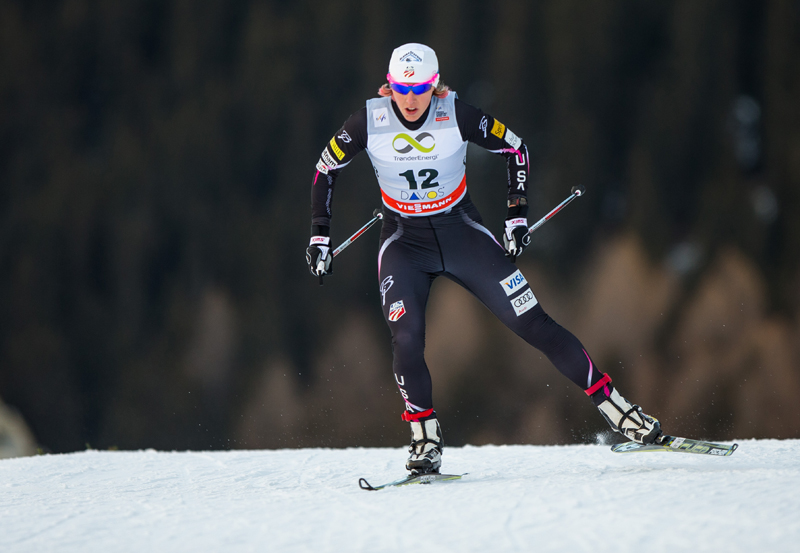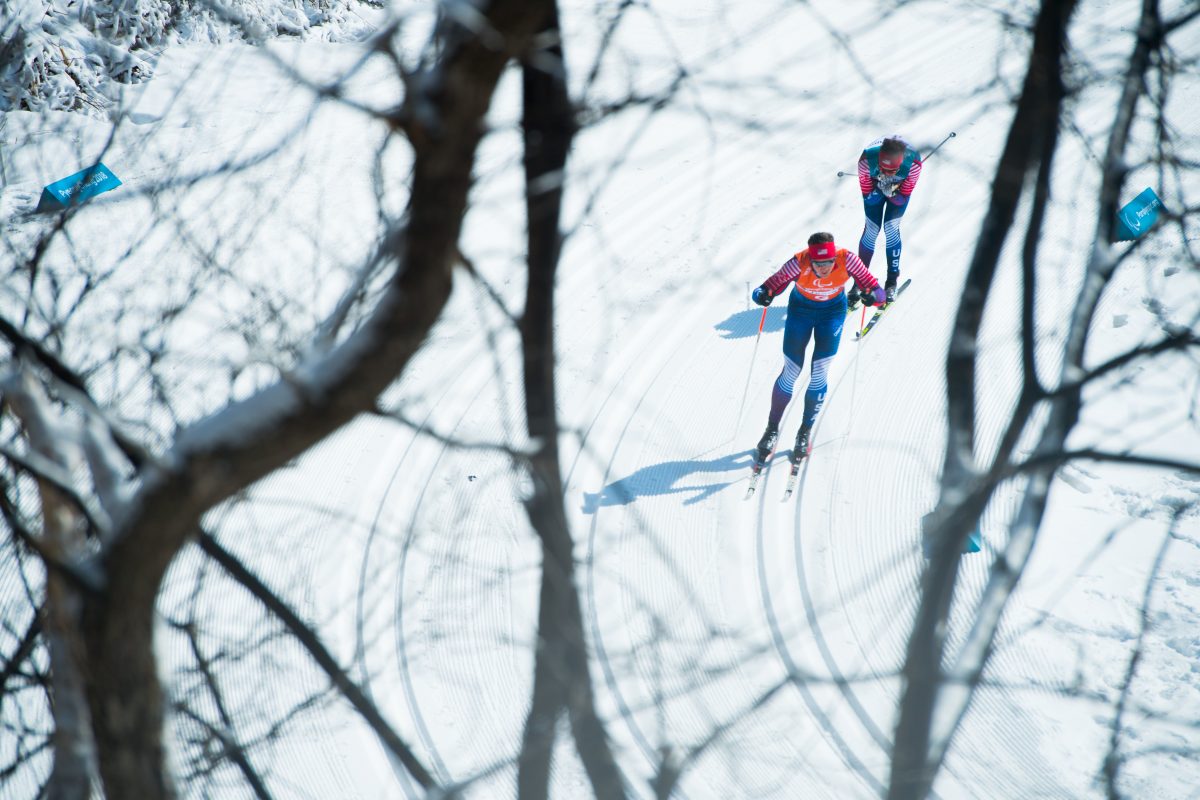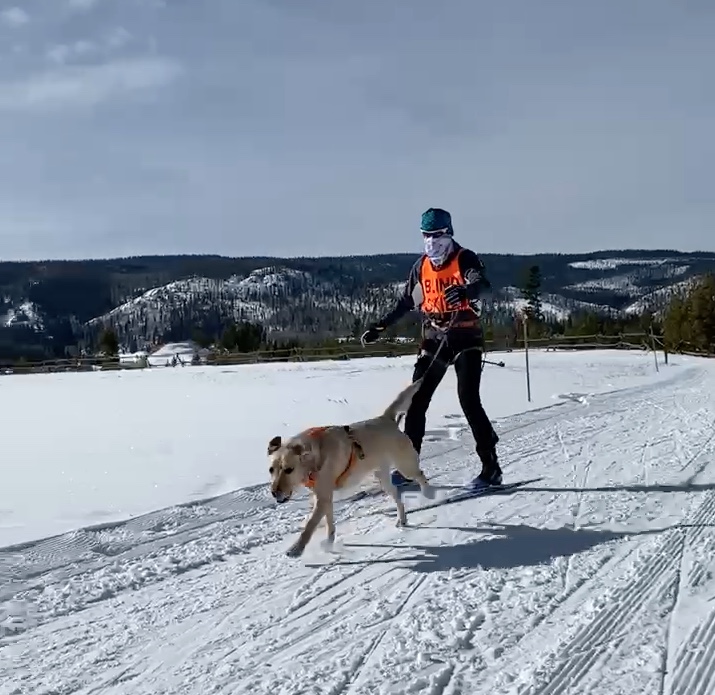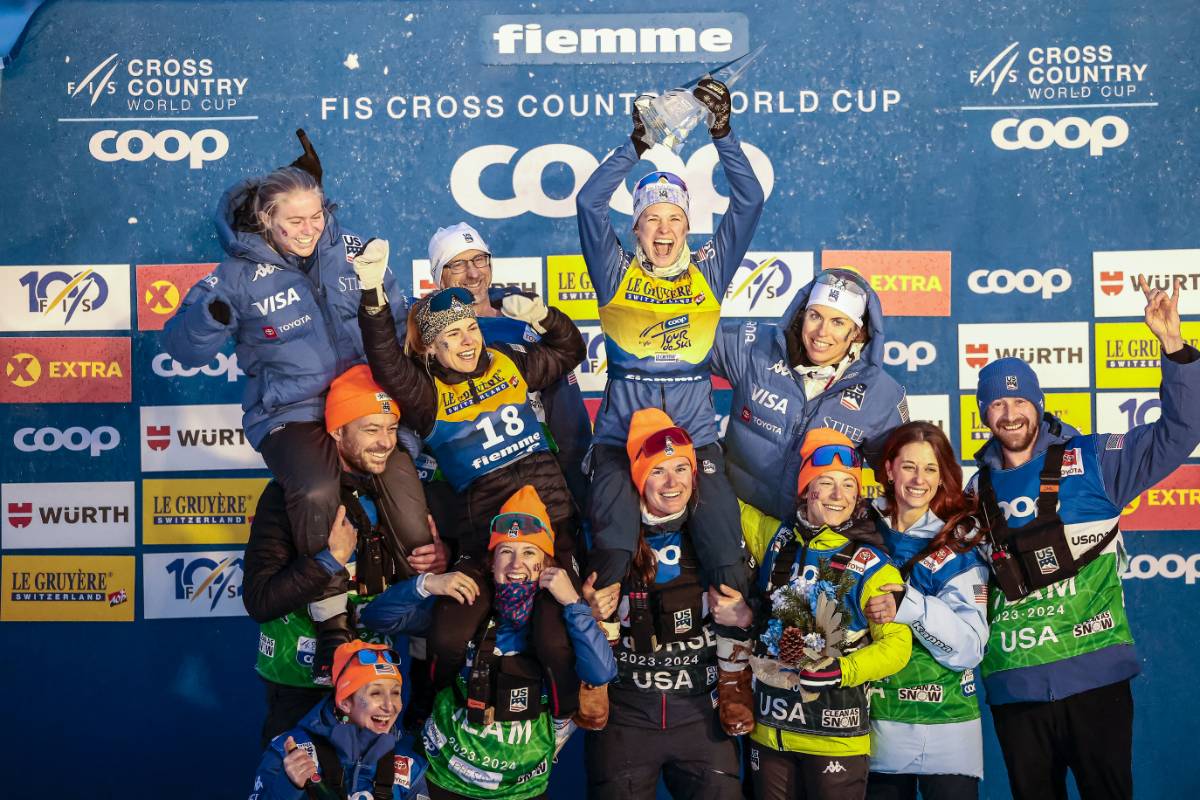We often hear of the pipeline in Olympic sport. The path to the highest level of elite competition. The pipeline is not consistent in diameter: Wide-mouthed at its start, tapered to needle-wide at its terminus. There are many ways to identify talent within a pipeline. In the cross-country ski world, there are incremental benchmarks to progress to the next tier. Within U.S. Ski & Snowboard, for example, skiers in the pipeline begin in the club system and might progress from local, regional, Junior Nationals, Junior Worlds, to senior-level racing.
It’s a system with a relatively steady influx of skiers at the pipeline’s intake.

One aspect of the product, the potential to advance in the pipeline, can, in many ways, sell itself. If you live in a mountain town or northern latitude city, odds are cross-country skiing is on the menu of outdoor activities for certain demographics. Two American women winning gold in 2018 is also a wonderful sales pitch to aspirants. This healthy lifestyle and medal-winning context afford stakeholders a modicum of breathing room when considering marketing approaches to athlete recruitment and the ability to maintain pre-existing participants. Although the problem of attrition in youth sports is real, and cross-country skiing is no exception, junior-level ski racing remains popular in traditional cross-country ski hotbeds.

The Para side of the sport, however, must take a more active approach when it comes to marketing. Drawing athletes into the Para Nordic disciplines requires a significant time investment with national-level coaches often meeting in small groups with raw beginners to introduce their respective disciplines.
A few weeks back, US Para Nordic hosted a Zoom call for visually impaired (VI) athletes and families interested in learning more about how to become involved.
Two US Para Nordic coaches were on the Zoom call, Kristina Trygstad-Saari, and BethAnn Chamberlain, along with several veteran athletes and a few newcomers. In terms of grassroots, this was the seeding process. A visually impaired participant logged in from Los Angeles, another potential visually impaired athlete, a teenager, logged in from Indiana. Neither had easy access to snow. Neither had skied before.
A basic Q & A ensued. There was nothing extravagant about the presentation. Lots of nuts and bolts. Let’s call it pithy. Yet, the level of engagement was high. The meeting, which could have trended towards perfunctory, was not. By the end of the call, maybe 45 minutes later, the hook was sunk.
My intent for listening in was to learn how US Para Nordic pitches their sport and attracts prospects to their respective pipeline, and then write up a brief story. I became sidetracked.
***
Fifty-two-year-old VI biathlete Michael Stone, who spoke during the Zoom call, was my hook setter. Stone resides in Boulder, Colorado. According to Stone, his first race of any kind was the Bolder Boulder — an iconic 10-kilometer road running race that snakes through Boulder’s neighborhoods and finishes in a packed Folsom Field on the University of Colorado campus.
“That was probably one of the most spectacular days of my life. And since then, over 21 years, I’ve done over 230 races,” said Stone.

In 2003, Stone completed his first Ironman. That race, in contrast to Stone’s first Bolder Boulder experience, was inauspicious. The race was in New Zealand, and at one point Stone inadvertently took a wrong turn. “I remember one of the course marshals yelled, ‘What are you blind?’ At that moment, I actually wondered if I was,” recalled Stone. “I mean, I remember feeling very, you know, dejected.”
There’s a backstory here worth telling. Post-New Zealand, Stone returned to his childhood home in Chicago to seek advice from his family physician.
The abridged version of Stone’s adolescence, which the doctor took notes on, goes something like this. A caring family that exposed Stone and his siblings to sports and the arts. There were eventual vacations to Aspen for downhill skiing which Stone began to dread. “Everybody else would be exhilarated and I’d be miserable,” said Stone. “We’d be skiing in the trees and I’d fall, and not even know why. I was screwed, even in good light. And it should have been a good indicator that something wasn’t adding up.”
There were attempts at ball sports where Stone often could not see the ball thrown his way. There were laughs, and the “he sucks” microaggressions.
“At some point, you just stay away from sports because it’s intimidating, it just eats away at your soul,” said Stone. “For a young person struggling, with their vision of something undiagnosed like dyslexia, every aspect of life is going to be very hard.”
Stone withdrew. He folded himself into music where he learned to play the guitar and other instruments. “That’s where I hid from the world,” he said.
But if you thrive on moving your body, as Stone does, the draw of sports can be irresistible. Stone eventually found martial arts, and then rock climbing – which initially brought him out to Boulder. According to Stone, hearing his climbing partners constantly tell him where to place his hands and feet pushed him out, saying it became too exhausting emotionally. He purchased a bike and he began to run.
Then there was that goose-bump Bolder Boulder where Stone came running into that packed stadium. “It was just such a spectacular feeling that I forgot all about anything related to my vision or whatever,” said Stone. “It was simply that I ran six miles and that was huge.” Then came the Ironmans and the demeaning “What are you blind?” comment from the course marshall.
***
Back in Chicago, Stone visited his physician and then a specialist who sent him to another specialist. The MD-PhD diagnosed Stone with a genetic degenerative disease called retinitis pigmentosa. The disease affects the retina’s photoreceptors.
“The doctor was just beside himself,” said Stone. “He asked, ‘How have you gotten through life like this?’ It was like he knew everything, and he quickly told me what my life was like because obviously, it was a familiar story to him with sports and with school and family life, everything, he just sort of knew it. He had been diagnosing these things for probably 40 years. He was shocked that I had gone through life undiagnosed.”
Stone said he had most likely been legally blind since he was five. His youngest brother was also diagnosed with the disease. Eventually, they traced the gene back in the family’s genealogical tree.
The diagnosis helped Stone define his life trajectory. But as a successful hotel and spa developer, Stone has not defined himself solely as an endurance athlete. He is, like many role models among us, capable of compensating, adapting, thriving, and finding community. Stone understands his predicament but moves forward. He knows he’ll occasionally miss his toothbrush with the toothpaste, have issues making a simple cup of coffee, or have difficulty finding a public bathroom. Stone navigates a physical and emotional culture set up for the able-bodied. He’s still out there riding, running, swimming, skiing, and running a business — all at a high level.
During some background reading about life as a visually impaired person, I came across this excellent story in the New York Times: Is There a Right Way to Act Blind by Andrew Leland. In short, Leland, who himself is blind, keenly explores how some people experience blindness, but also how sighted actors portray blind characters.
This passage from Leland’s piece caught my attention: “I recently spent a weekend with a friend who has been blind since childhood. I watched him pat and fumble for objects, but he did so in a way that struck me as utterly assured, and entirely unembarrassed — his fingers scanned the table just as your eyes might: quickly, casually, without apology. I aspire to this kind of blindness. The only way to get there, I suspect, is through rehearsal — practicing until my blind presence becomes convincing, if not to the world then at least to myself.”
Leland’s words, for me, resonated. It was a reminder that we travel the world on a gradient. We are constantly aspiring to be “utterly assured, and entirely unembarrassed.” I’m still trying to let that all sink in and imagine what that might be like for someone experiencing a disability and hailing a cab, or simply bathing. Let alone performing an endurance sport like biathlon at a high level.
***
Stone discovered cross-country skiing over a decade ago and ultimately found an interest in biathlon. Para biathletes use an audio rifle with no live rounds. As the biathlete aims closer to the target, remember, this is the visually impaired class, the noise projected from the rifle becomes higher pitched. The VI athlete pulls the trigger when they sense via the rifle’s audio signal the shot is on target. Like able-bodied biathlon, keeping range time to a minimum is part of the challenge.

Stone admits, although he is an accomplished triathlete, that he desires more independence. He rides on a tandem bike, and in some situations remains tethered to a sighted guide when running. Stone equates freedom with cross-country skiing. The closest he feels to being able-bodied is when he is skiing and then shooting on the biathlon range, explained Stone.
“Cross-country skiing is one of the most spectacular sensations because it’s the closest thing I get to freedom and independence out of any sport I do,” said Stone. “I’m not tethered cross-country skiing, as I would be for running or swimming like we do in triathlon, I’m not on the back of a tandem. We’re on our own skis, on our own snow, and we have our own mistakes to make. We do get lefts and we get rights and a few whoops as verbal cues from a sighted guide, just to keep straight. And once we drop down in the shooting range, as we always shoot prone, it is pure freedom.”
In the Para Nordic biathlon world, VI athletes are relatively scarce. That makes sense considering the logistics of transport, arranging a sighted guide if needed, and having access to a rifle and shooting range, let alone snow. Stone, for his part, has become an unassuming ambassador who wants to give back to a community of coaches and peers who have refeinforced his self-assurance. He is, as I came to realize, the perfect salesperson for any athlete hoping to get motivated and seize any opportunity.

“I’m not a young guy, and so when there are younger people, say in their teens and 20s and 30s, I don’t want them to miss out on this opportunity to experience biathlon — not to mention, just to be able to experience the love we get from the coaches,” said Stone. “I really don’t know why it’s there, they’re like higher beings to me. Nobody should face the world alone. And the fact that there are people that are willing and capable to at least try to walk in your shoes and create an opportunity for you when there are really few opportunities in this world that will be generated like this. I live by only a couple really important codes and one of them is you owe your best to the people who love you most.”
My impression from Stone is that he could do most anything he wanted with his life. It’s a good thing he found cross-country skiing and biathlon. We’re better for it.
For information about becoming a sighted guide, or becoming involved as an athlete, here’s a link to US Para Nordic’s recruiting survey.
To learn more about how a VI biathlete shoots on the range, watch the video below. The on-range segment begins at approximately 2:55.
Jason Albert
Jason lives in Bend, Ore., and can often be seen chasing his two boys around town. He’s a self-proclaimed audio geek. That all started back in the early 1990s when he convinced a naive public radio editor he should report a story from Alaska’s, Ruth Gorge. Now, Jason’s common companion is his field-recording gear.



